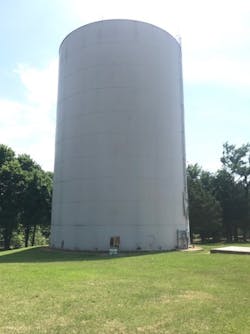When supplying water to a community, delivering fresh and clean water is of utmost importance. The city of Searcy, Ark. is no different than any other city in America, with plans and procedures in place to make sure citizens receive safe water.
Searcy’s water system dates back to 1896, and originally included a well located in the southeast section of town and a pipe that was laid to reach the center of town. In 1899, the size of the system was increased when several citizens called for the establishment of the Searcy Electric Light, Sewer, and Waterworks Improvement District No. 1. The District was formed to facilitate and increase the utility services throughout the city, adding pumps, pipes, a standpipe, and well hydrants throughout the service area.
Modern Times for Searcy Water Utilities
“Our water source is very dynamic,” says Scotty Boggs, assistant general manager at Searcy Water Utilities. Boggs highlighted that the water in Searcy is naturally considered aggressive. “There’s not a lot of minerals or buffering and it’s on the corrosive side.”
Searcy Water Utilities sells about 54 percent of their water to wholesale customers and surrounding communities. The remainder of the water is used for residential and industrial purposes. Currently, Searcy Water Utilities has a total of four tanks in the distribution system with mixers.
“As a water operator in any type of ground storage reservoir or standpipe, mixing is imperative,” says Boggs.
Corrosive Water Problems
Although mixers were in place in all four storage tanks, Searcy’s naturally corrosive water began to cause problems for certain mixers.
“Our first mixer was in our 4-million-gallon water ground storage tank. Being a shorter tank at 32 feet tall, it was an easy install, but the main issue was that we experienced a motor failure,” says Boggs.
He mentioned that there were high amps which kept tripping the breaker. After receiving a replacement mixer, no more than three short years later, the mixer had the same motor failure.
“We took apart the bad mixer. It has a very complex system. Evidently, over a 3-year span, the seals begin to fail,” says Boggs.
Once the water gets past the seals, it causes a catastrophic failure to the mixer.
“The entire time, the bearings are exposed to the water and cause a motor failure,” says Boggs. “This has happened to us twice now.”
Boggs also highlighted that the seals with their other mixers were not designed to handle the chlorinated water that runs through the system. From this moment, Boggs and the Searcy Water Utilities crew decided enough was enough.
“It’s a big deal to pull a mixer out of a tank; it’s a big inconvenience. Even if somebody was giving us a free mixer, the physical requirements of pulling the unit out and putting a new unit in are such an impedance. The taller the tank, the more drastic the situation becomes,” says Boggs.
Active Mixers Installed
Searcy Water Utilities has a close relationship with Instrument Supply Incorporated (ISI) located in Hot Springs, Ark. ISI gave an initial push to implement two CertiSafe by Kasco standard mixers in two of the four tanks.
One of the tanks is a 300,000-standpipe that is 125 feet tall. Its mixer is powered by a solar grid which converts to alternating current (AC) power and operates the mixer. The other mixer is a standard 110-volt CertiSafe unit in a million-gallon storage tank which stands about 72 feet tall.
“Both mixing units are mounted halfway down the tank rather than thrown to the bottom of the tank,” Boggs says. “It can be mounted on the bottom, but we didn’t need to. Engineers looked at the install and decided there would be better mixing for the standpipe ground storage reservoirs at this location in the tank.”
The Searcy Water team worked with Kasco on the engineering plan for the installation. This included submitting plans to the health department to ensure compliance with State of Arkansas protocols in place for disinfecting equipment, completing sampling, and testing.
“We didn’t have to drain the tank or anything close to that,” says Boggs. “We developed an engineering and testing plan to get it done. We didn’t waste a teacup of water which was very nice.”
CertiSafe mixers are NSF-certified with food grade mineral oil in their mixers. The oil in the active mixer circulates the water faster and more efficiently than tanks that do not include food grade mineral oil. The oil also provides better cooling to the motor, allowing it to operate more efficiently and extend service life. This allows the mixers to provide more mixing with less maintenance.
Boggs mentions that, with the mineral oil lubricating the motor, it is much more difficult and unlikely that the water would encroach and push itself into the air-filled cavity within the mixer.
Better for Business
Boggs expects the new mixers to last at least twice as long as the previous mixers.
“It’s been out of sight, out of mind,” says Boggs. “Our only requirement is to go by and make sure it’s still working properly. It’s not a maintenance consideration at all. We just verify that it’s still operational.”
During the installation, there can be situations where a complete draining of the tank is required — but this was not the case for Searcy Water Utilities.
“Sometimes they require people to physically get in the tank, but this install involved disinfecting the equipment, lowering it in on a chain, and fixing a bracket on the chain to hold the unit up,” Boggs adds. “We were able to get it back online right away.”
With the responsibility of delivering water to the community of Searcy and beyond, Boggs mentioned how thankful he was to work alongside Kasco.
“It was nice to have their expertise. It’s a relief to not have to worry about our new mixers. I would rather have mixers that are going to last. It’s one less thing to worry about,” says Boggs.
When it comes to mixing, Boggs and his team know the importance of having an efficient tank mixer.
“I really think you are doing yourself a disservice if you don’t have some sort of blending or mixing in a tank,” he says. “As far as the CertiSafe unit goes, the simplicity and the robust design of it — having a motor cavity filled with oil where water can’t get into it and the simple propeller type system — makes the most sense to me. Simplicity is a good thing.” WW
Published in WaterWorld magazine, August 2022.
About the Author
Lucy Allen
Lucy Allen is the Municipal Business Development Manager for Kasco Marine. She has more than 15 years of experience in the water and wastewater industry and is an expert on water tank mixing.

